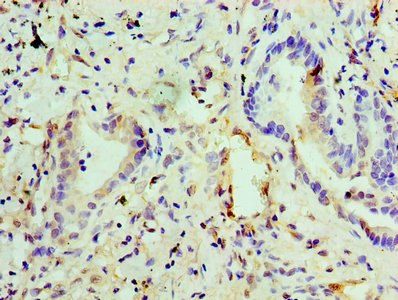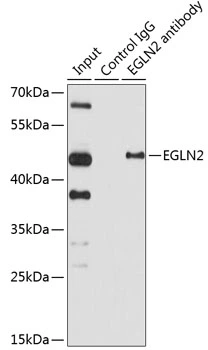
Immunohistochemistry of paraffin-embedded human lung tissue using CSB-PA007482EA01HU at dilution of 1:100
EGLN2 Antibody
CSB-PA007482EA01HU
ApplicationsImmunoFluorescence, ELISA, ImmunoHistoChemistry
Product group Antibodies
ReactivityHuman
TargetEGLN2
Overview
- SupplierCusabio
- Product NameEGLN2 Antibody
- Delivery Days Customer20
- ApplicationsImmunoFluorescence, ELISA, ImmunoHistoChemistry
- CertificationResearch Use Only
- ClonalityPolyclonal
- ConjugateUnconjugated
- Gene ID112398
- Target nameEGLN2
- Target descriptionegl-9 family hypoxia inducible factor 2
- Target synonymsEIT-6, EIT6, HIF-PH1, HIFPH1, HPH-1, HPH-3, PHD1, prolyl hydroxylase EGLN2, HIF-prolyl hydroxylase 1, egl nine homolog 2, estrogen-induced tag 6, hypoxia-inducible factor prolyl hydroxylase 1, prolyl hydroxylase domain-containing protein 1
- HostRabbit
- IsotypeIgG
- Protein IDQ96KS0
- Protein NameProlyl hydroxylase EGLN2
- Scientific DescriptionCellular oxygen sensor that catalyzes, under normoxic conditions, the post-translational formation of 4-hydroxyproline in hypoxia-inducible factor (HIF) alpha proteins. Hydroxylates a specific proline found in each of the oxygen-dependent degradation (ODD) domains (N-terminal, NODD, and C-terminal, CODD) of HIF1A. Also hydroxylates HIF2A. Has a preference for the CODD site for both HIF1A and HIF2A. Hydroxylated HIFs are then targeted for proteasomal degradation via the von Hippel-Lindau ubiquitination complex. Under hypoxic conditions, the hydroxylation reaction is attenuated allowing HIFs to escape degradation resulting in their translocation to the nucleus, heterodimerization with HIF1B, and increased expression of hypoxy-inducible genes. EGLN2 is involved in regulating hypoxia tolerance and apoptosis in cardiac and skeletal muscle. Also regulates susceptibility to normoxic oxidative neuronal death. Links oxygen sensing to cell cycle and primary cilia formation by hydroxylating the critical centrosome component CEP192 which promotes its ubiquitination and subsequent proteasomal degradation. Hydroxylates IKBKB, mediating NF-kappaB activation in hypoxic conditions. Target proteins are preferencially recognized via a LXXLAP motif.
- ReactivityHuman
- Storage Instruction-20°C or -80°C
- UNSPSC41116161








